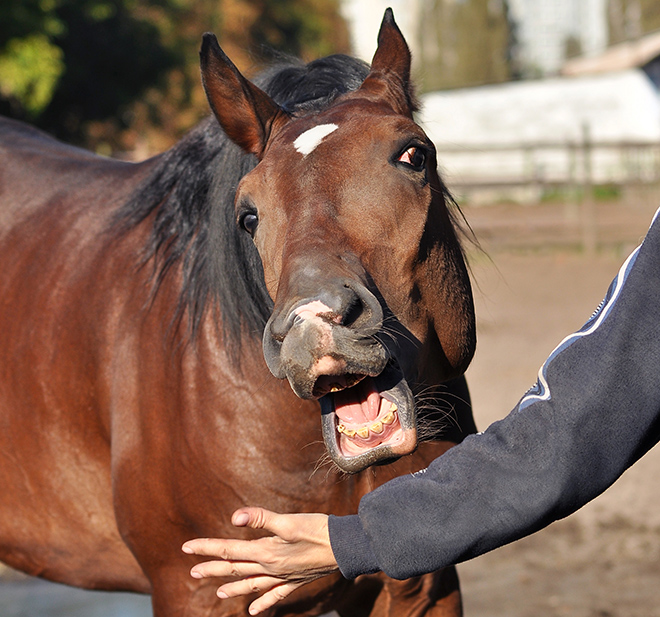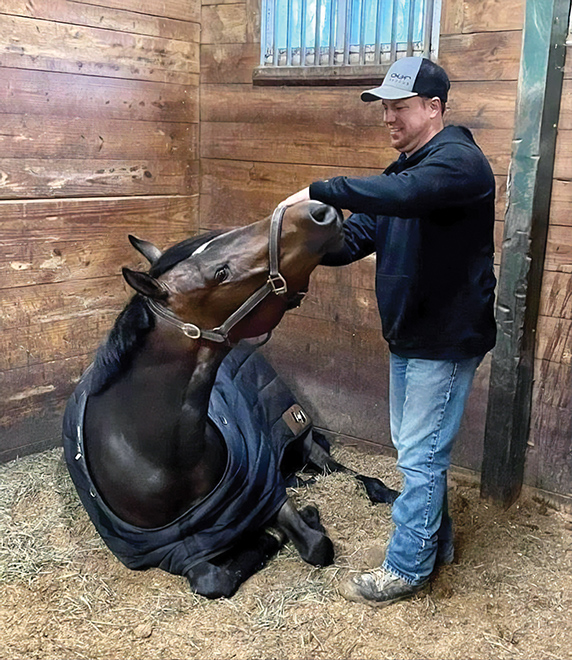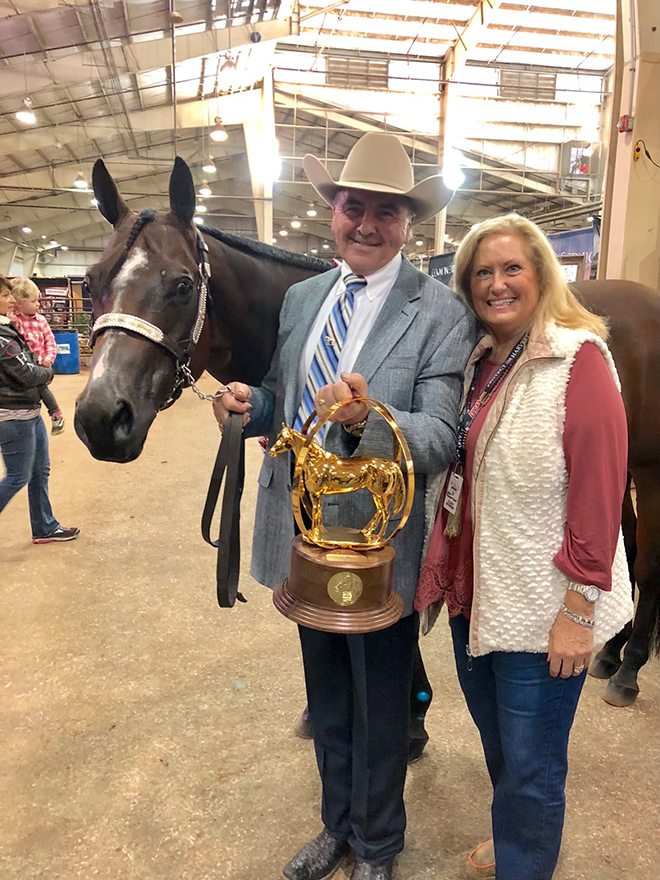For some horse owners, giving peppermints and cookies, scratches and attention are the largest time-consuming part of their horse’s daily catering routine.
While there’s nothing wrong with wanting the special and close attachment with a horse, their manners and behaviors can turn pushy and rude instead of being respectful and considerate to the people whom they spend most of their time with. Creating a spoiled monster has never been so easily done in the barns across the country, where endless treats and rewards are freely given for questionable work ethics and abrupt surly impatient mood swings that are either overlooked or made to be a funny cutesy joke.
Just like children, horses need to be taught what are some of the appropriate behaviors people find favorable and what mannerisms they’re expected to avoid. This isn’t an easy task as human and horse communication capabilities are limited causing confusing and blurry relationship rules. It’s a lot to ask of a horse when they’re processing the dealing with the consequences of life’s right and wrong decisions. With any type of learning and maturing, horses and humans need patience, guidance, consequences and motivation to want to behave their best and form lifelong agreeable habits as they seek the comfortable path of less resistance.
Without realizing it, owners can accidently send mixed messages to their horse on what exactly is expected of them in different situations. It’s on the human when we knowingly let the naughty manners continue being uncorrected that can quickly lead to self-centered and mean behaviors that easily end up establishing spoiled and dangerous habits, ultimately turning the horse into an overindulged temper-tantrum baby. With vets, farriers, barn employees, family members and trainers having to handle the entitled and spoiled 1000-pound animals safely can be an overwhelming and risky predicament. Even the sweetest spoiled horses are the most soured and bitter to work around and spend time with.
Seeking help from a professional will not only help guide owners through installing the most respectful etiquette but will also help eliminate the unpleasant characteristics the horse has managed to pick up and master.
Advice from Taft Dickerson …from the ground up
Dickerson, with wife Adrienne, own Dickerson Show Horses in Carlisle, Pennsylvania, where they cover colt breaking to fine tuning the finished all around show horse. Taft says that he spends a lot of time on ground manners before expecting his horses to mind under saddle.
“I want a horse who can answer the questions on the ground first before we ask anything with a rider on their back,” he explained. “I don’t let my horses misbehave on the longe line and they’re not allowed to do anything naughty that they shouldn’t do with a rider on their back. I take a no-nonsense approach with their learning on the ground and on the lounge line. I like them to pick up the correct leads when loping, move forward when asked and stop when told, just like as if I was riding them. I want their nose flexed to the inside of our circle ready and willing to perform the next cue I give.”
Since riding introduces its own challenges, Taft likes to know that his horse has the basics to fall back on, in order to keep the learning moving at a comfortable pace, building trust along the way.
“Setbacks happen but that doesn’t mean that the learning and understanding stops, it’s better to have basic decent manners invested and part of their personality when having a re-set or re-teaching moment. It gives the horse confidence in any new experience,” he said.
A horse who will run over the top of you to get into their stall is one of Taft’s biggest pet peeves when it comes to bad ground behavior.
“First I need to find out if this is a learned habit or if it’s a new reaction,” he said. “I start by backing the horse into their stall and then asking the horse to stand still at the door. If I need to add more control for my safety then I might attach a chain to the lead rope continuing to back the horse up in the alley before asking them to walk calmly in. This sort of rushing behavior in a horse must be monitored so I don’t hurry the process and I always take my time. With horses like this, it’s helpful to back out of arena gates and dismount then walk back to the barn together with a respectful 12 inches of distance between you and the horse.”
Taft isn’t that keen about handing out treats to his horses in general, but when a horse deserves more than a few scratches, he likes to put a hay bag in front of them to enjoy rather than cloud the expectations he has for them not to nibble or worse, bite.
With Farley McLendon…consistency counts
This Whitesboro, Texas all-around trainer owns McLendon Show Horses and first questions the health of a horse who is showing signs of a spoiled attitude and work ethic. Farley McLendon looks for underlying issues, such as soundness and digestive trouble like stomach ulcers that could be a contributing factor.
“The habits that go hand in hand with this type of negative thinking are ear pinning, tail swishing, general meanness and the lack of mental toughness that often stems from something else going on with the horse,” she said. “If they pass a medical exam and continue to show poor work attitudes, I then take a closer look to see if it’s a stressful response to what is being asked of them during schooling and even change up their discipline events. If making changes doesn’t help, then honestly the horse will probably demonstrate some weakened work ethic in whatever they may be asked to do. It’s unfortunate when this happens for everyone involved, especially the horse.”
In addition to having your horse dislike their job and role in life, Farley says that regaining control over that unconstructive mind-set could take a short time to years and consistency plays a huge part. She describes a 3-year old stallion in her program who rode around like a 10-day broke colt, he had zero respect and even less patience. This stud didn’t know how to focus on her or what she was asking him to do.
“The first few weeks were endless wet saddle pads while putting him into a consistent routine,” she said. “Once we got into that steady training, we loaded him up and went on a weekend field trip, where he totally reverted and lost his attention again. It took the whole weekend to get his mind back but he did come back. After that weekend, he figured out he had a purpose and a job to do, learning if he did put in the effort willingly then life was more enjoyable for him and he was rewarded for his choice to work together with me. About two months in, I put a well-known fence trainer on him and he was able to jump a line and change leads, finding he liked to be challenged more during his schooling. Six months later, he was sold to a wonderful select rider and both couldn’t be happier with each other.”
In her daily work as a trainer, McLendon’s biggest pet peeve is when a horse has been allowed to turn and bolt when scared, on the ground and in the saddle.
“Yes, it’s OK for them to be unsure and nervous–but letting them run from it makes it all worse,” she said. “They need to trust their rider to go forward and past whatever is scaring them without losing concentration. Once again this is where consistency pays off. Just like when a horse wants to walk all over you. I usually start by leading them and if they get too close, I will stop and back them up out of my space, doing this as many times at it takes. Sometimes this takes several days with brief little reminders along the way, so putting a time limit doesn’t benefit the horse or the situation. Over the course of trying to change any spoiled horse’s outlook it’s important for them to be willing to correct their bold and unwanted behavior. Walking over you, bolting away in fear and not being able to keep their awareness and focus on you and their job, generally goes together with the horse being impatient and inconsistent.”
Jane Backes’ magic is in her mares…but also in manners
Top AQHA breeder, Jane Backes has large grassy turnout pastures for her broodmares, babies and young horses in Tiago, Texas at her family’s ranch. She says in her line of work, one person has to be able to easily catch and handle a mare or baby or both at the same time. Well-mannered horses cut the work load in half, she explains, and it’s even better if the mare is comfortable enough to trust whoever is around her baby.
“Bad mannered mares raise bad mannered babies, which are harder to train when they’re young and down the road in life,” she said. “When I get a spoiled recipient mare, I work with her to establish better manners and be more considerate and respectful in her behavior before she foals to give the baby a better start.”
She insists you can tell the mares in her herd that were once show horses verses ones that went straight out to the breeding shed or came from a recipient farm, as those tend to be herd bound with fewer manners and less patience.
Backes says she’s a fan of giving cookies as a reward for mares and babies learning right from wrong. A deal breaker is any horse who uses their front legs to strike out.
“It’s easier to remember to stay away from a horse’s hind end but when a horse uses their head, shoulders and front legs it’s more difficult for the handler to stand and handle the horse safely,” she explained.
When you have to catch horses alone, Backes says a cookie goes a long way. She doesn’t even need halters on her babies outside in the pastures because they learn that they get something they love – a treat and will walk right up when it’s time to be caught.
“I try not to give my show horses in training cookies because a lot of the trainers frown upon it, depending on how they run their program,” she said. “Now, once my own horses are home, the cookies are free choice.”
Turnout time… with Anthony Leier
“I suggest leaving the growing horse outside as long as you can before their training career starts. Let them be babies and don’t create unwanted habits that develop when they are bored in stalls,” said Anthony Leier, trainer and owner of Leier Performance Horses in Pilot Point, Texas. In his yearling Longe Line program, Leier says gaining respect from a horse doesn’t involve dominance or fear but patience.
“With young ones, I feel like slow repetitive schooling that allows both giving-and-taking helps create a strong bond of trust, and spoiled horses don’t seem to understand that compromise,” he said. “Usually that imbalance damages the respect that surrounds personal space all handlers and riders need to have.”
Leier insists his youngsters learn to respect their handlers’ personal space. When he has an owner, who drops off a spoiled horse that has been hand-fed treats, it’s the important personal space rule that needs to be addressed first. It will eventually register with them that any time they are close enough to touch you they have a space boundary that limits too close interaction. Feeding treats in their feeder in their stall is a good way to reinforce that rule.
“All my broodmares get cookies, even by hand, but in my mind, I believe they have earned it,” he said. “My yearlings don’t get treats, but extra alfalfa. My reward to all my yearlings is turnout. We let them have a few hours daily to just be horses and unwind. That to me, is the best treat you can give a show horse that doesn’t cause or influence spoiled behavior.”
Anne Prince/trainer Tyler Haney…Handy work at Prince Farm
In Palmetto, Florida at Prince Farm, head trainer Tyler Haney says when it comes to giving treats, it depends on the horse.
“Some can handle it from time to time without being pushy and can keep it all polite,” he explained. “With other horses, who are known to be a little more assertive and curious, it’s not an option. Once you get to know their body language and individual personalities, I trust my gut when it comes to hand feeding treats. It’s never an all the time practice – we use moderation and often treats are given for special occasions like training breakthroughs or new accomplishments.”
At Chester and Anne Prince’s farm, a common-sense approach is taken.
“I do enjoy being able to reward horses with a treat and I can do so without creating any bad habits by simply putting the cookie in the horse’s feed pan.” Anne said. “By not involving fingers to mouths, it helps stop horses from being mouthy, nibbling and constantly searching for treats and invading the handler’s personal space. This reinforces that I respect their space and in return I want them to respect mine. They all know to go to their feed pan for the cookie and they also know who the cookie is from, which makes me feel like I’m pampering and spoiling them without really doing so.”
For Tom and Mary Robertson… The earlier the better
The Robertsons like to make a positive impact as soon as possible and love taking in the four-month-old weanlings to start preparing them for their Halter careers. Mary says their training starts right when they open the babies’ stall doors.
“We start by teaching what is acceptable and what isn’t, when we open the stall door,” she explained. “We want to see a happy friendly face waiting to be greeted and caught, not a face that hides in the corner and swings a rear-end toward us. We have expectations of our horses, no matter their age to have willing and pleasant mannerisms that come from firm compassion and kindness that make our jobs easier and safer.”
Mary explains that training, prep and show times are close proximity working environments and there’s no room for bad attitudes or space for big egos. Allowing a horse to lift a leg in protest when people are working in their space can be a dangerous warning sign.
“There’s so much going on to them and around them, that it’s normal for them to get excited and nervous, but it’s never OK for them to act aggressively, even if they are expressing natural reactions,” she said. “To help condition our horses, we do everything at home that they will have done away from home at shows. We make it all very routine from oiling their hooves, putting tails in and clipping whiskers, ears and bridle paths year-round. Creating a normalcy and ‘just another day’ of pampering even in the rushed excitement at the shows.”
In the Halter world, peppermints serve a purpose in the show ring. The crinkle noise of the wrapper grabs the attention of a squared-up horse in the show arena and promotes ears to stay forward happily while they concentrate on the sweet treat. The Robertson’s tack rooms, grooming boxes and even pockets are filled with the white and red mints that are used as a successful training tool.
“We love to love our horses,” Mary said. “Tom is always rewarding good manners and a job well done, being affectionate with each and every one is our way of spoiling them by reinforcing what behaviors we want. When they choose to be good, then life with us is very good,” Mary said.
By looking at the big picture, an overly pampered horse could just be mirroring the same qualities and traits that their owners choose for communication and interacting. Remembering that everyone and every horse will have questionable manners from time to time, as perfect manners don’t exist. The true reward, is the big picture, one supported with safe teamwork from a bonded partnership that never allows aggressive behavior to harm the relationship that both rider and horse have worked so hard to achieve together.









You must be logged in to post a comment Login